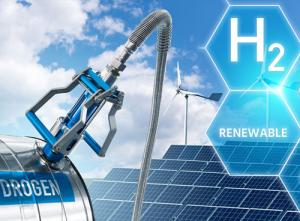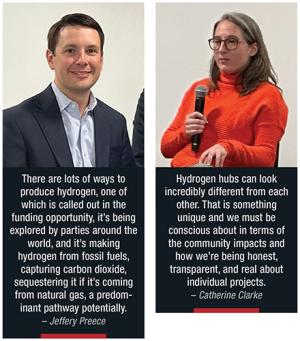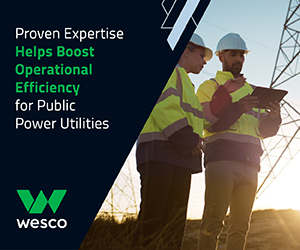EPRI
Moderator Jeffery Preece is Low-Carbon Resources R&D Director at EPRI. Rudra Kapila is Senior Policy Advisor for Carbon Management at Third Way. Traci Kraus is Director of Government Relations at Cummins. Alex Kizer Senior VP of Research and Analysis at the Energy Futures Initiative. Catherine Clarke is Energy Justice Liaison for the U.S. DOE Office of Clean Energy Demonstrations.
EPRI in early May held a roundtable featuring subject-matter experts sharing best practices and insights on the vital role of meaningful community engagement in successfully deploying hydrogen projects economy-wide. In A Community Approach to Hydrogen Development, the discussion focused on analyzing the role of active community engagement in infrastructure development.

The growth of today's hydrogen ecosystem presents an opportunity for industry and communities to collaborate, and the panelists highlighted ways to move forward. The event also featured the release of an EPRI-Hydrogen Forward Factsheet on community engagement best practices.
Panelists included Third Way Senior Policy Advisor for Carbon Management Rudra Kapila, Cummins Director of Government Relations Traci Kraus, Energy Futures Initiative Senior VP of Research and Analysis Alex Kizer, U.S. DOE Office of Clean Energy Demonstrations Energy Justice Liaison Catherine Clarke, and moderator and EPRI Low-Carbon Resources R&D Director Jeffery Preece. Enjoy these excerpts.
Cummins Director of Government Relations Traci Kraus: Cummins is an over one hundred-year-old company that is traditionally known for making big diesel truck engines. Of the trucks you see on the road, about forty have a Cummins engine, but almost all of them have a Cummins component, whether that's turbocharger, fuel systems, or electronic controls.
We also make big diesel power generators that do backup for hospitals, data centers, the Statue of Liberty, and provide power for construction equipment and agricultural equipment. We are in the hardest to abate sectors and in applications that require a lot of power density.
 Traci Kraus
Traci Kraus
We've got an ambitious decarbonization plan, planned to be net zero in all our products, facilities, and operations up to Scope 3 by 2050, with interim steps along the way. Hydrogen was one of those key enablers to decarbonize hard-to-abate sectors in a meaningful way.
We've invested a significant amount of capital, not only to make the electrolyzers that produce green hydrogen, fuel cells, which run on it, but also, we're transitioning our internal combustion engines to run on clean fuels, including a hydrogen internal combustion engine, which is one of the best ways that we can see community benefits from the hydrogen transition today.
That's because we think these engines are capable of running at a much lower cost than fuel cells in trucks used in ports, trucks doing urban delivery and pickups, basically applications that can be switched over immediately because the hydrogen engine is the same size and spec as the diesel engine, so you can replace like for like.
There's a big jobs impact on training and schooling. We're already partnering with colleges around the country and training programs to get folks who have traditionally been employed as diesel technicians to now start working on hydrogen fueling and hydrogen systems.
 Rudra Kapila and Alex Kizer
Rudra Kapila and Alex Kizer
We're developing that workforce for the eventual transition to fuel cells, which we're investing in. We do not see this as displacing or an alternative to fuel cells, but rather hydrogen internal combustion as facilitating that transition and allowing us to do it immediately.
There's the air quality impact. When we're able to transition to hydrogen engines, we can get down to the absolute lowest levels of NOx and particulate matter as required by the EPA in California.
In addition to having zero carbon, our latest understanding is that the EPA would classify a hydrogen internal combustion engine as a zero-carbon engine for their latest fuel efficiency rules. Some of these investments, even in our traditional technology, will be critical to realizing these community benefits.
They're keeping folks at our diesel plants employed. We announced a big investment in our Fridley, Minnesota, manufacturing facility, where we make the big diesel and natural gas power generators.
 Jeffery Preece and Catherine Clarke
Jeffery Preece and Catherine Clarke
We've added a large electrolyzer manufacturing line there. A great thing about our workforce at Fridley is we've got a lot of electrical engineers and electricity technicians who know how to integrate into the grid, which is a fantastic skill to manufacture electrolyzers.
We are reskilling, retooling, and hiring more folks from this community right outside of Minneapolis with a large Somali population. It's a great opportunity to reinvest in that workforce, the community, and provide longevity for the next one hundred years.
Moderator and EPRI Low-Carbon Resources R&D Director Jeffery Preece: Alex, Energy Futures Initiative recently produced your hydrogen Demand Action Plan, and it identifies "prioritizing local and regional workforce development and community benefits within DOE's hydrogen hub program." What do you think prioritization looks like, and what have you found in terms of models or examples that should be considered or replicated?
Energy Futures Initiative Senior VP of Research and Analysis Alex Kizer: We're a D.C. based think tank founded by former Energy Secretary, Ernie Moniz. We try to tackle a lot of these issues related to the low-carbon transition, and hydrogen is something I've been leading for the last few years. This report, Demand Action Plan, is the framing, but within that, we house critical issues including a major focus on community engagement.
What we found through our travels developing this project, which included over two hundred interviews, three regional workshops to look at hydrogen and the opportunity from different angles are, where's the demand going to come from, as well as how can communities be engaged in a way that improves upon current practices?
A common thread was tangible benefits, or how can we get specific about addressing community needs? That's what it comes down to, finding out for the hub developers, what does a community need and want, and how can those needs and wants be prioritized? It's both complicated, but it's also somewhat simple.
Each community in each region, and defining communities, are we talking about tribal labor, energy communities as the IRA talks about, the list goes on, frontline and energy justice. There're a lot of different types of community groups but getting to the heart of that issue about what they need, want, and what does the process look like, to answer those questions is key.
In our study, we have a few recommendations including building on, monitor, reporting, and verification of these projects, and they should have a community engagement component, because that has to do with issues like hydrogen leakage or natural gas leakage, depending on the production type and the system type.
But that impacts local air quality and environmental issues at the heart of some of these community groups' concerns. That would be a tangible part of that prioritization.
A key issue in this report but not the sole focus is, we've started a new effort solely focused on what community engagement looks like, should look like, and are trying to engage community groups and hydrogen project and hub developers, to understand areas of commonality and divergence across some of these key parameters.
I'll share a couple of early observations that binding commitments are key. Binding commitments can be tricky because funding has not been awarded.
That needs to be a focus, married to this idea of how to understand what the specific community groups in our areas of the project need and want. Those might be non-hydrogen related, such as public transportation, public transit, education, and healthcare, because as Justice40 discusses, it's forty percent of the benefits.
How those will be specifically defined, I'll let experts talk about, not me, but thinking about those in the ways that marry what the community needs is what we're trying to do here.
Moderator Jeffery Preece: From the Department of Energy's perspective, is hydrogen unique in terms of the communities, engagement plans, and support needed to attain the approvals or buy-in? Are there any areas or applications within other parts of energy, other sectors, DOE thinks could be helpful in trying to recognize the priority that should be put on community engagement?
U.S. DOE Office of Clean Energy Demonstrations Energy Justice Liaison Catherine Clarke: One of the challenges now is, as these big proposals are coming together with lots of players or big geography with different technology types, there's no way starting at a few months into that process, people are going to already understand all the community dynamics and have built all the relationships needed for meaningful, impactful engagement.
It's about setting up the plans for robust mechanisms like formal agreements, community benefit agreements or project labor agreements, et cetera, because those mechanisms are what enable that long-term trust building and mechanisms for engagement to impact how the project unfolds. That piece is critical.
From nuclear to solar, there're some good examples of how community engagement has been done in shaped projects. Overall, there's a big level of inconsistency in how community engagement has been implemented. Hydrogen is relatively new, so we're starting to see that come out.
From our perspective, building on everything, it's a bit like going back to the basics and fundamentals of what it means to do in good engagement in OCED, our office. We're at the starting part of that process internally by having a robust engagement team.
I sit on the engagement team, we have twenty people, most of those full-time Feds are dedicated to engagement in our office, and that's unprecedented for DOE. We don't just exist in our engagement office; we're integrated into the project teams.
What we learn from our engagement outside can be implemented and impact how we're doing our projects, and there's that direct feedback loop between what we hear from communities and how we're implementing our projects.
That approach where you have mechanisms whereby what you're learning and what you're hearing about the priorities, concerns, and having specific mechanisms to adapt the project to meet the community where they're at, is critical.
In terms of the uniqueness of hydrogen, there're a lot of ways to produce, transport, and use hydrogen. Because of that, it can be harder to define in a universal way what the impacts are going to be.
Being on a specific project level, transparent and honest about, for this project, with this protection mechanism, transportation mechanism, and end use, these are what the impacts of this project are going to be, and not just saying, oh, clean hydrogen's better, end of story.
Hydrogen hubs can look incredibly different from each other. That is something unique and we must be conscious about in terms of the community impacts and how we're being honest, transparent, and real about individual projects.
Moderator Jeffery Preece: There are lots of ways to produce hydrogen, one of which is called out in the funding opportunity, it's being explored by parties around the world, and it's making hydrogen from fossil fuels, capturing carbon dioxide, sequestering it if it's coming from natural gas, a predominant pathway potentially.
Dr. Kapila, what are your perspectives on the community engagement component where carbon dioxide is now in the mix in addition to hydrogen? Where do we need to be having conversations and engaging communities on understanding carbon dioxide capture storage and long-term impacts?
Third Way Senior Policy Advisor for Carbon Management Rudra Kapila: It's not just carbon dioxide, when we're talking about fossil-derived hydrogen production, we've also got to tackle methane. Upstream emissions are still an issue, especially with steam methane reformation in the U.S., if we are adding carbon capture units onto it, it's also upstream emissions that need to be factored into overall lifecycle analysis.
Hydrogen leakage is an issue. Hydrogen's a real bugger in terms of storage, transport, and any form of hydrogen leakage, particularly at ground level, is going to react and form ozone, and ozone has a far more potent global warming potential.
When you're crafting legislation, when you're designing projects, there must be considerations for all these other potentials. You must be honest about how these projects are being developed.
I'm adamant about having fossil-derived hydrogen and electrolytic hydrogen. There is a project that Third Way did with Gansler, which is an architecture firm. There were five in total, and the underlying theme was direct air capture in all of them.
We do have a point source capture on clean steel with DAC. This one is a hydrogen hub, and it's electrolytic. We've got a decommissioned oil and gas platform on which there sits an electrolyzer powered by offshore wind, and there's a blending facility, and their DAC units are on board.
The reason why I'm mentioning this is, the whole purpose of this project was about educating communities. First, we wanted to create a vision of all the various projects funded through BIL and IRA, which are large, complex, technological systems.
It's not just about hydrogen production, there's an element of transport and storage. There're a host of other things for the entire value chain to consider as these clean energy ecosystems that we're building.
It's not only various parts of the value chain, but also where the construction jobs and office jobs are. The crux is there are technological configurations of producing hydrogen, be it fossil derived or electrolytic based on renewables or nuclear. What does this technology look like? Communities don't know.
That is a key part of doing community engagement, and it's critical for deploying, is having an effective way of imagining these technologies, how communities play into it, and which benefits they can get from it.




